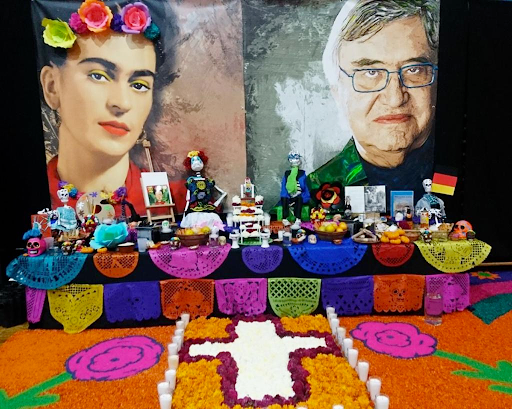
The Day of the Dead or Dia de Los Muertos is a holiday that is celebrated in many countries around the world, but it is most often associated with Mexico. From the zestful fiestas of Mexico to the somber memorials in Spain, two cultures display their unique traditions of tribute on the Day of the Dead. While there are many similarities between the two celebrations, there are also some important distinctions that set them apart.
The holiday’s origins can be found in an Aztec celebration dedicated to the deity Mictecacihuatl. A full month was dedicated to the festival, which took place in the ninth month of the Aztec calendar. Following the Spanish conquest of Mexico, the celebration was shifted to November 1st and 2nd to align with the Catholic holidays of All Saints’ Day and All Souls’ Day respectively.
The celebrations in Mexico are truly a sight to behold. The festive atmosphere and vividly-hued costumes capture the essence of their commemoration for the dead. The rich, appetizing aroma of the food combined with the fragrance from the flowers permeates throughout the city. Families honor their loved ones by setting up ofrendas, which are altars beautifully decorated with cempasúchil (marigolds), and candles. Delicious offerings such as the traditional Pan de Muertos, a sweet bread specially prepared for the holiday, are laid out in honor of the departed family members. Families also offer calaveras, which are sugar skulls decorated with colorful icing. Josue Garcia Patino, an OHS student from Mexico, recounts, “In my ofrenda at home I put the photo of my grandmother and my great grandparents and for food, I put coffee, bread, chocolate, mole, tostadas, tamales and chocolate and sugar skulls in commemoration of their spirit.
Furthermore, the holiday is celebrated in schools, where the students also partake in the festivities. As Patino says, “In the schools, they also place an altar choosing an outstanding person and in the same way, they put photos, food, flowers, and papel picado, and in addition to that they perform commemorative dances dressed as catrines and catrinas.”
In Spain, Dia de Los Muertos, also known as Dia de Los Difuntos, is celebrated with its own variations. Families pay respects to their departed loved ones at their gravesites, presenting flowers and candles. While the occasion is usually private, some towns hold processions where people carry candles and walk through the streets at night. As in Mexico, food is also an important part of Dia de Los Muertos. According to Annaliese, an OHS student who lives in Spain, “Most people only bring flowers to the graves of their ancestors, have a family dinner, and eat castañas and panellets.”
Dia de Los Difuntos is a more solemn celebration in Spain. There are no parades or festivals as in Mexico, but people still go to graves to pay their respects to the deceased. Celebration is not the main focus; rather, it is sorrow and remembering. While there are some regions in Spain where public celebrations are held, most families in Spain prefer to keep to themselves. OHS student Pau Barrera says, “It’s a very personal thing here in Spain.” Despite these differences, the essence of the holiday remains in both countries.
Over time, Spain has increasingly embraced Western cultural influences and drifted away from the traditional celebrations of Dia de Los Difuntos. Pau shares that over the years, the festival has lost its significance in Spain.
He says, “The only region where el Día de los Difuntos has stayed as a tradition is the Canary Islands. Across the whole of Spain, most people have replaced el Día de los Difuntos with el Día de Todos los Santos, on which we go to the cemetery and celebrate our deceased relatives and put flowers on their tombs.”
Diana McDermott, another OHSer from Spain says, “The point of the celebration is not to grieve, but rather to remember their loved ones, though there isn’t quite as much celebration as I’ve heard there is in Mexico.”
Patino from Mexico says that the spirit of Día de Muertos is rooted in ensuring that the deceased are kept alive in the memories of those who love them, a sentiment echoed in his family’s saying, “The dead die when the living forget them.”
